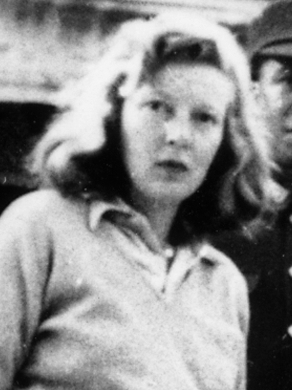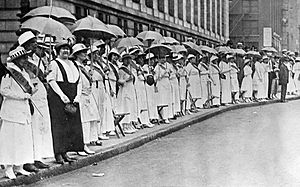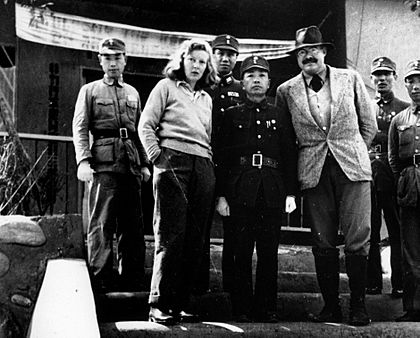Martha Gellhorn facts for kids
Quick facts for kids
Martha Gellhorn
|
|
|---|---|

Gellhorn, 1941
|
|
| Born | Martha Ellis Gellhorn 8 November 1908 St. Louis, Missouri, US |
| Died | 15 February 1998 (aged 89) London, England |
| Occupation | Author, war correspondent |
| Period | 1934–1989 |
| Genre | War, travel |
| Spouse |
T. S. Matthews
(m. 1954; div. 1963) |
Martha Ellis Gellhorn (born November 8, 1908 – died February 15, 1998) was an American writer and journalist. She is known as one of the greatest war correspondents of the 20th century.
Gellhorn reported on almost every major world conflict during her 60-year career. She was also married to the famous American novelist Ernest Hemingway from 1940 to 1945. The Martha Gellhorn Prize for Journalism is named after her. This award honors journalists who report on human suffering.
Contents
Early Life and First Steps in Journalism
Martha Gellhorn was born in St. Louis, Missouri, on November 8, 1908. Her mother, Edna Fischel Gellhorn, was a suffragist, which means she worked for women's right to vote. Her father, George Gellhorn, was a doctor.
When Martha was seven, she took part in a special event called "The Golden Lane." This was a rally for women's voting rights in St. Louis in 1916. Girls like Martha stood in front of a line of women. These women carried yellow umbrellas and wore yellow sashes. They showed that they wanted women to have the right to vote. Martha and another girl represented the future voters.
Martha finished high school in St. Louis in 1926. She then went to Bryn Mawr College. But she left college after a year to become a journalist. Her first articles were printed in The New Republic magazine.
Becoming a Foreign Correspondent
In 1930, Martha decided she wanted to report from other countries. She moved to France for two years. She worked for a news agency called United Press in Paris. After that, she traveled around Europe. She wrote for newspapers in Paris and St. Louis. She even covered fashion for Vogue magazine. She also became involved in the pacifist movement, which promotes peace. She wrote about these experiences in her 1934 book, What Mad Pursuit.
In 1932, Gellhorn returned to the United States. She met Harry Hopkins through her friend, First Lady Eleanor Roosevelt. The Roosevelts invited Martha to live at the White House. There, she helped Eleanor Roosevelt with her letters and newspaper column. Martha was hired to investigate for the Federal Emergency Relief Administration (FERA). This government group helped people during the Great Depression.
Martha traveled across the U.S. to report on how the Depression affected people. She worked with photographer Dorothea Lange. They documented the lives of hungry and homeless people. Their reports helped the government understand the crisis. Martha used her research to write a collection of short stories called The Trouble I've Seen (1936).
Reporting on World War II and Marriage
Martha Gellhorn met Ernest Hemingway in 1936 in Key West, Florida. He was a famous writer. Martha was hired to report on the Spanish Civil War for Collier's magazine. She and Hemingway traveled to Spain together. They spent Christmas of 1937 in Barcelona.
Martha also reported on the rise of Adolf Hitler in Germany. She was in Czechoslovakia in 1938, before World War II began. She wrote about these events in her novel A Stricken Field (1940). She then reported on the war from Finland, Hong Kong, Burma, Singapore, and England.
Reporting on D-Day
In June 1944, Martha wanted to report on the Normandy landings in France. But the British government did not allow female journalists to go. So, Martha pretended to be a nurse. She got onto a hospital ship and hid in a bathroom. Two days later, she landed in Normandy. She saw many wounded soldiers and helped as a stretcher-bearer. She later said, "I followed the war wherever I could reach it." She was the only woman to land at Normandy on D-Day, June 6, 1944.
She was also one of the first journalists to report from Dachau concentration camp. This was after U.S. troops freed the camp on April 29, 1945.
Marriage to Ernest Hemingway
Gellhorn and Hemingway lived together for four years before marrying in November 1940. Hemingway became upset when Martha was away for long periods. She was busy reporting on the war. For example, she left their home in Cuba in 1943 to cover the Italian Front.
Hemingway later went to the front lines just before D-Day. Martha also went, even though Hemingway tried to stop her. She traveled by a dangerous ocean voyage to London. When she arrived, she told him she had had enough. They divorced in 1945 after four years of arguments.
The 2012 movie Hemingway & Gellhorn is about their marriage. The 2011 documentary No Job for a Woman: The Women Who Fought to Report WWII also features Gellhorn. It shows how she changed war reporting.
Later Career and Travels
After World War II, Martha Gellhorn continued her work. She reported for The Atlantic magazine. She covered the Vietnam War and conflicts between Arabs and Israelis in the 1960s and 1970s.
Even after turning 70 in 1979, she kept working. She covered civil wars in Central America. As she neared 80, her body started to slow down. She managed to cover the U.S. invasion of Panama in 1989. But she finally retired from journalism in the early 1990s. An eye surgery was not successful, leaving her with poor eyesight. She said she was "too old" to cover the Balkan conflicts in the 1990s.
Martha made one last trip overseas in 1995. She went to Brazil to report on poverty there. This report was published in Granta literary journal. It was very hard for her to do this because her eyesight was so bad. She could not even read her own notes.
Her Books
Gellhorn wrote many books. These include:
- The Face of War (1959): A collection of her articles about war.
- The Lowest Trees Have Tops (1967): A novel about McCarthyism, a time when people were accused of being communists.
- Travels with Myself and Another (1978): A book about her travels, including one trip with Hemingway.
- The View from the Ground (1988): A collection of her journalism from peacetime.
Martha was a "peripatetic" person, meaning she loved to travel and move around. She figured she had made homes in 19 different places during 40 years of her life.
Personal Life and Independence
Martha Gellhorn did not like being known only as Ernest Hemingway's wife. She often said she did not want to be "a footnote in someone else's life." When people interviewed her, she would ask them not to mention Hemingway's name. She once said, "I've been a writer for over 40 years. I was a writer before I met him and I was a writer after I left him. Why should I be merely a footnote in his life?"
In 1954, she married T. S. Matthews, who was an editor for Time Magazine. They divorced in 1963. She lived in London for a while, then in Kenya, and later in Wales. She liked the people in Wales and lived there from 1980 to 1994. She then returned to London because of her health.
In 1949, Martha adopted a boy named Sandro from an Italian orphanage. She named him George Alexander Gellhorn, but everyone called him Sandy. Martha was a loving mother for a time. But she was not naturally a very "maternal" person. She often left Sandy with relatives while she traveled. He later went to boarding school.
Martha Gellhorn also had a strong friendship with the writer Sybille Bedford. They met in Rome in 1949. Their friendship lasted for many years. Martha often gave her friend moral, creative, and financial support.
Death and Legacy
In her last years, Martha Gellhorn was not in good health. She died in London on February 15, 1998.
The Martha Gellhorn Prize for Journalism was created in 1999 to honor her. This award recognizes journalists who write about human suffering.
In 2019, a special blue plaque was put on Martha Gellhorn's old home in London. It was the first plaque to call someone a "war correspondent." In 2021, a purple plaque was placed on the cottage she lived in near Kilgwrrwg, Wales. This is part of a plan to honor amazing women.
In Popular Culture
Martha Gellhorn has been honored in several ways:
- On October 5, 2007, the United States Postal Service announced that she would be on a first-class postage stamp. This stamp was released on April 22, 2008.
- In 2011, Gellhorn was featured in an episode of the TV series Extraordinary Women. This show aired on the BBC and PBS.
- In 2012, actress Nicole Kidman played Martha Gellhorn in the film Hemingway & Gellhorn.
- Martha Gellhorn's relationship with Ernest Hemingway is also the subject of the 2018 novel Love and Ruin by Paula McLain.
- In 2021, a documentary called Hemingway was released. It was made by Ken Burns and Lynn Novick. It included many photos and videos of Gellhorn. The actress Meryl Streep provided Gellhorn's voice in the documentary.
See also
 In Spanish: Martha Gellhorn para niños
In Spanish: Martha Gellhorn para niños




